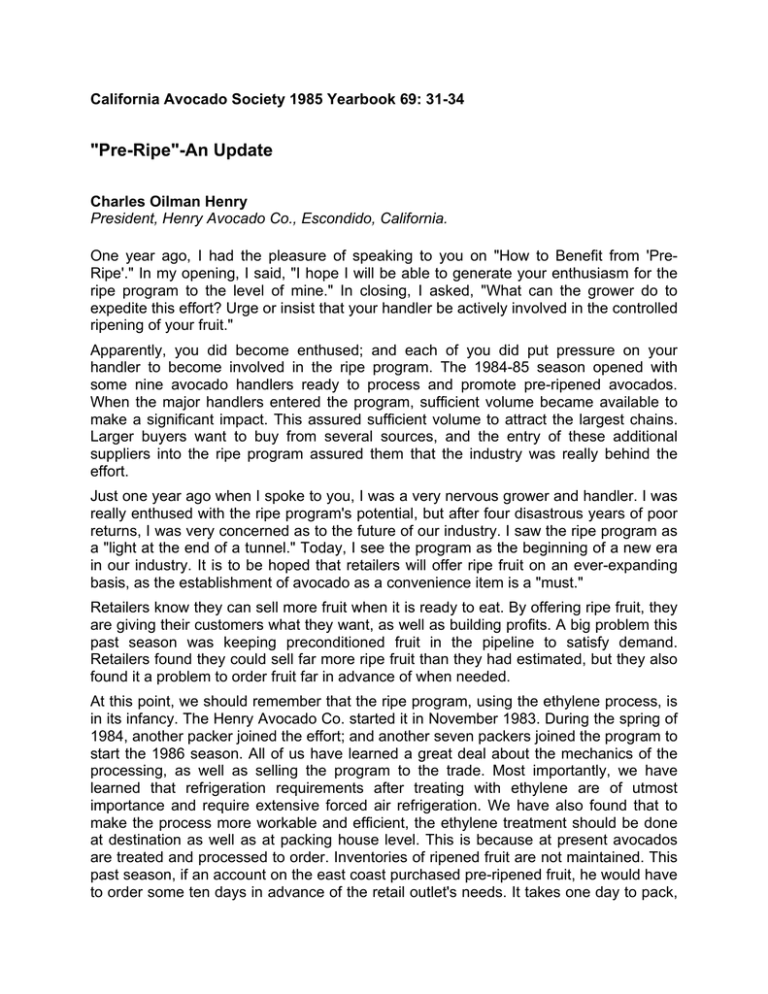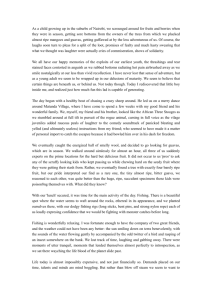"Pre-Ripe"-An Update
advertisement

California Avocado Society 1985 Yearbook 69: 31-34 "Pre-Ripe"-An Update Charles Oilman Henry President, Henry Avocado Co., Escondido, California. One year ago, I had the pleasure of speaking to you on "How to Benefit from 'PreRipe'." In my opening, I said, "I hope I will be able to generate your enthusiasm for the ripe program to the level of mine." In closing, I asked, "What can the grower do to expedite this effort? Urge or insist that your handler be actively involved in the controlled ripening of your fruit." Apparently, you did become enthused; and each of you did put pressure on your handler to become involved in the ripe program. The 1984-85 season opened with some nine avocado handlers ready to process and promote pre-ripened avocados. When the major handlers entered the program, sufficient volume became available to make a significant impact. This assured sufficient volume to attract the largest chains. Larger buyers want to buy from several sources, and the entry of these additional suppliers into the ripe program assured them that the industry was really behind the effort. Just one year ago when I spoke to you, I was a very nervous grower and handler. I was really enthused with the ripe program's potential, but after four disastrous years of poor returns, I was very concerned as to the future of our industry. I saw the ripe program as a "light at the end of a tunnel." Today, I see the program as the beginning of a new era in our industry. It is to be hoped that retailers will offer ripe fruit on an ever-expanding basis, as the establishment of avocado as a convenience item is a "must." Retailers know they can sell more fruit when it is ready to eat. By offering ripe fruit, they are giving their customers what they want, as well as building profits. A big problem this past season was keeping preconditioned fruit in the pipeline to satisfy demand. Retailers found they could sell far more ripe fruit than they had estimated, but they also found it a problem to order fruit far in advance of when needed. At this point, we should remember that the ripe program, using the ethylene process, is in its infancy. The Henry Avocado Co. started it in November 1983. During the spring of 1984, another packer joined the effort; and another seven packers joined the program to start the 1986 season. All of us have learned a great deal about the mechanics of the processing, as well as selling the program to the trade. Most importantly, we have learned that refrigeration requirements after treating with ethylene are of utmost importance and require extensive forced air refrigeration. We have also found that to make the process more workable and efficient, the ethylene treatment should be done at destination as well as at packing house level. This is because at present avocados are treated and processed to order. Inventories of ripened fruit are not maintained. This past season, if an account on the east coast purchased pre-ripened fruit, he would have to order some ten days in advance of the retail outlet's needs. It takes one day to pack, one day to stabilize the temperature at 68-70 degrees, one day for the ethylene application, and one day to bring the temperature down to 40 degrees. Then add four days transit time to the east coast warehouse, and then one or two more days to get the fruit to the retail stores. This time frame can be shortened immensely by this same warehouse maintaining an inventory of hard fruit and using their existing banana room to process their avocados as needed. Considerable refrigeration savings would be effected as well as much less transit damage. If done in this manner, the treatment could be accomplished in three days instead of ten. Several major chains are doing this now, and many more will do it in the future. Obviously, this takes some training of the banana room operator; but the increased sales of avocados, and meeting the customers' desires, will mandate such operation. The quality of fruit ripened with the ethylene process has been far superior. The treatment assures evenness of ripening and eliminates rubberiness. This is most noticeable in long-necked fruit. It also eliminates hard spots in the late season fruit. Ethylene treatment is now being used for bananas, melons, papayas, mangos, and kiwifruit. It enhances the product in all cases. Last year, I made the statement, "Our industry must change the product we offer. We must offer fruit in a ready to eat condition to gain repeat sales faster." Those of us in the ripening program have experienced exactly that. With the ethylene treatment, we have made the avocado a convenience item. We are changing our product from "unusable" at time of purchase to "usable," just as are apples, bananas, tomatoes, and other items found in the produce department. Avocado growers realize the benefits to be gained from the sale of preripened fruit in high returns. This season, our industry moved 50% more Hass through March than was moved in the prior year, and at far better prices. The ripe program was the catalyst that made this possible. We are now enjoying record prices at record volumes. Our industry has introduced the product and publicized the advantages of handling ripe fruit. Certainly, everyone is aware of the ripe program. Now our industry faces the challenge of taking this "awareness" to "action." I believe this can be done by: 1. The fullest possible use of trade advertising and publicity documenting the increased sales by retailers and institutional users of pre-ripened fruit. 2. The communication to produce merchandisers and buyers that their banana rooms can be put to additional usage. 3. The teaching of banana room operators to process avocados in their own facilities. Obviously, this is a tremendous job and requires an on-going effort for many years to come. I feel it should be financed through the California Avocado Commission and that this effort should be top priority. The commission has taken a most constructive approach toward the ripe program, and I am sure their efforts will be greatly expanded this coming season. The "ripe-program" is an effort to convince retailers to offer fruit in a ready to eat condition. It should not be just an ethylene treatment program. The ethylene treatment is most valuable early in the season or for those seeking predictability and uniformity. Our goal is to offer ripened fruit - regardless of how it is ripened. By making our product a convenience item, we are increasing sales to existing users. We are starting to get demand ahead of supply. Returns to growers have improved. The ripe program is expanding faster than anyone thought possible; but it's only the beginning, folks — only the beginning.


